| INVESTIGATION
An Evolutionarily Conserved Role of Presenilin in
Neuronal Protection in the Aging
Drosophila
Brain
Jongkyun Kang,* Sarah Shin,* Norbert Perrimon,†,‡,1and Jie Shen*,§,1 *Department of Neurology, Brigham and Women’s Hospital,†Department of Genetics, Harvard Medical Shcool,‡Howard Hughes Medical Institute, and§Program in Neuroscience, Harvard Medical School, Boston, Massachusetts 02115
ABSTRACTMutations in thePresenilingenes are the major genetic cause of Alzheimer’s disease. Presenilin and Nicastrin are essential components ofg-secretase, a multi-subunit protease that cleaves Type I transmembrane proteins. Genetic studies in mice previously demonstrated that conditional inactivation of Presenilin or Nicastrin in excitatory neurons of the postnatal forebrain results in memory deficits, synaptic impairment, and age-dependent neurodegeneration. The roles ofDrosophila Presenilin(Psn) andNicastrin(Nct) in the adultfly brain, however, are unknown. To knockdown (KD)PsnorNctselectively in neurons of the adult brain, we generated multiple shRNA lines. Using a ubiquitous driver, these shRNA lines resulted in 80–90% reduction of mRNA and pupal lethality—a phenotype that is shared withPsnandNctmutants carrying nonsense mutations. Furthermore, expression of these shRNAs in the wing disc caused notching wing phenotypes, which are also shared with Psn and Nct mutants. Similar to Nct, neuron-specific Psn KD using two independent shRNA lines led to early mortality and rough eye phenotypes, which were rescued by aflyPsntransgene. Interestingly, conditional KD (cKD) ofPsnorNctin adult neurons using theelav-Gal4andtubulin-Gal80tssystem caused shortened lifespan, climbing defects, increases in apoptosis, and age-dependent neurodegeneration. Together, these findings demonstrate that, similar to their mammalian counterparts,DrosophilaPsn and Nct are required for neuronal survival during aging and normal lifespan, highlighting an evolutionarily conserved role of Presenilin in neuronal protection in the aging brain.
KEYWORDSg-secretase; Alzheimer’s disease; conditional knockdown; shRNA; brain
P
RESENILIN (PS) is the catalytic subunit of theg-secretase complex, which also contains Nicastrin (Nct) and cleaves type I transmembrane proteins, such as the Notch recep-tors (De Strooperet al.1999; Songet al.1999; Struhl and Greenwald 1999; Li et al.2000; Yu et al.2000; Baiet al.2015). ThePresenilin-1(PSEN1) andPresenilin-2genes were identified as the major genes linked to familial Alzheimer’s disease (FAD) (Levy-Lahadet al.1995; Rogaevet al.1995; Schellenberg 1995). Genetic studies in mice have demon-strated that, in the developing brain, PS regulates neurogen-esis and cell-fate decisions through the Notch signaling pathway (Shenet al.1997; Handleret al.2000; Kim and Shen 2008), and that deficiency ofPSorNctresults in early
embryonic lethality (Donoviel et al. 1999; Nguyen et al.
2006). Conditional gene targeting further demonstrated that PS and Nct are required for normal learning and memory, synaptic plasticity, and neuronal survival in the mouse cere-bral cortex (Yuet al.2001; Beglopouloset al.2004; Fenget al.
2004; Saura et al.2004; Tabuchi et al.2009; Zhang et al.
2009; Wines-Samuelson et al. 2010; Lee et al. 2014;
Watanabeet al.2014).
Drosophila Presenilin(Psn) andNicastrin(Nct) share high sequence homology with their human and mouse counter-parts (Hong and Koo 1997; Yuet al.2000). Loss-of-function mutations inDrosophila Psncause pupal lethality and Notch-like phenotypes, such as maternal neurogenic effects, loss of lateral inhibition within proneural cell clusters, and absence of wing margin formation (Struhl and Greenwald 1999; Ye
et al. 1999). Loss-of-function mutations in Nct also cause pupal lethality, and abolish Psn accumulation and Psn-dependent intramembrane cleavage of Notch (Chung and Struhl 2001; Huet al.2002). Genetic modifier screens of Notch-like phe-notypes inPsn loss-of-function mutants also confirmed the genetic interaction betweenPsnandNctin theDrosophilaeye and wing (Mahoneyet al.2006). However, the pupal lethality
Copyright © 2017 by the Genetics Society of America doi:https://doi.org/10.1534/genetics.116.196881
Manuscript received October 17, 2016; accepted for publication May 5, 2017; published Early Online May 11, 2017.
Supplemental material is available online atwww.genetics.org/lookup/suppl/doi:10.
1534/genetics.116.196881/-/DC1.
ofPsnandNctmutants precluded studies of their functions in mature neurons of the adult brain. As a result, the conse-quences of Psn or Nct inactivation in adult neurons of thefly remain unknown.
In this study, we developed multiple shRNA lines targeting PsnorNct. Using theAct5c-Gal4driver, we found that ubiq-uitous Psnor Nctknockdown (KD) in all cells leads to an
80–90% reduction ofPsnorNctmRNA and pupal lethality, similar to homozygous null mutant flies (Lukinova et al.
1999; Struhl and Greenwald 1999; Huet al.2002). Selective PsnorNctKD in wing marginal discs caused notching phe-notypes in the adult wing, further confirming that thesePsn and NctshRNA lines effectively suppressPsnandNct func-tion, respectively. Similar toNct, neuron-specificPsnKD un-der the control of theelav-Gal4driver led to developmental defects, with dramatic early mortality, severe climbing de-fects, and rough eye phenotypes. Expression of aflyPsn trans-gene rescued the early mortality and rough eye phenotypes of neuron-specificPsnKD. Strikingly, adult neuron-specificPsn or Nct conditional KD (cKD) flies using the elav-Gal4/tub-Gal80ts system, which permits inducible expression of
shRNAs in adult neurons, displayed shortened lifespan, climbing defects, increases in apoptosis, and age-dependent neurodegeneration. Together, these findings demonstrate that similar to their mammalian orthologs, Drosophila Psn
andNctare required for adult neuronal survival during aging and normal lifespan, highlighting an evolutionally conserved role of Presenilin in neuronal protection in the aging brain.
Materials and Methods
Generation of Psn and Nct shRNA transgenicflies
We newly generatedUAS-shRNAlines againstPsn(shPsn1,2,
3,4) andNct(shNct1,2,3) as described (Niet al.2011), which are different from those available at TRiP. Briefly, shRNA tar-get regions were selected using a Perl program as described previously (Vertet al.2006), and we avoided the 59and 39 UTRs, and the regions that have.15 bp match to other Dro-sophilatranscripts, to reduce the risk of off-target effects. The annealed top and bottom oligos containing the 21 bp shRNA target sequences against Psn and Nct were subcloned into pWALIUM20 (TRiP) vector following the UAS sequence. The sequences of the oligos used to generateUAS-shPsnand UAS-shNcttransgenicflies are included in Supplemental Material,
Table S1. As described previously (Grothet al.2004; Venken
et al.2006; Marksteinet al.2008), each transgene was injected into embryos for targeted phiC31-mediated integration at ge-nomic attP landing sites on the second (attP16 or attP40) or third (attP2 or VK0027) chromosomes.
Crosses and culture conditions
Flies were raised on standard cornmeal media, and maintained at either 22 or 25°, and 40–60% relative humidity. Controlflies in all experiments were as closely related to the experimental transgenicflies as possible. Typically,UAS-shPsnorUAS-shNct,
and Gal4 transgenicflies were crossed withw1118 (Blooming-ton Drosophila Stock Center: BL5905) or P(CarryP)attP2
(BL36303) to generate the heterozygous alleles of the UAS-shRNAor Gal4 transgene. We used ubiquitous (Act5C-Gal4), wing-specific (c96-Gal4) or neuron-specific (elav-Gal4c155)
drivers to generatePsnorNctKD; female Gal4 transgenicflies were crossed with maleUAS-shRNAflies. For the rescue exper-iments,elav-Gal4/FM6;;UAS-shPsn2/TM6Bfemaleflies were crossed with maleflies of humanUAS-hPSEN1orDrosophila UAS-Psn+14. The progeny with the desired genotype ( elav-Gal4/+ (or y);; UAS-shPsn2/UAS-hPSEN1 or UAS-Psn+14) was collected based on the absence of genetic markers in the FM6 and TM6B balancers.
To generate adult neuron-specific Psn orNct cKDflies,
elav-Gal4;; tub-Gal80ts females were crossed with UAS-shPsn2orUAS-shNct2maleflies at a permissive temperature of 22°, and maintained at 22°until adulthood, then male offspring (elav-Gal4/y;; tub-Gal80ts/UAS-shPsn2 or UAS-shNct2) were collected and shifted to a restrictive tempera-ture of 27°until the end of each experiment. To generate adult neuron-specific Psn/Nct cKD flies, elav-Gal4;; tub-Gal80ts, UAS-shPsn2/TM6B females were crossed with UAS-shNct2 male flies at 22°, and maintained at 22° until adulthood, then male offspring (elav-Gal4/y;; tub-Gal80ts, UAS-shPsn2/UAS-shNct2) were collected and shifted to 27°
until the end of each experiment. All stocks were obtained from the BloomingtonDrosophilaStock Center unless other-wise indicated.
Quantitative RT-PCR (qRT-PCR)
Five third-instar larvae were washed twice in RNase free PBS and collected in lysis buffer. Fifteen third-instar larval brains were dissected in RNase free PBS, and homogenized in lysis buffer using a homogenizing blender (Next Advance). For adultfly RNA extraction, adultflies were collected and frozen immediately in liquid nitrogen. Five whole adult bodies were used for total RNA extraction. Twenty adult heads were re-moved from bodies by vortexing, and then collected. Total RNA was extracted according to the manufacturer’s instruc-tions (Quick-RNA MicroPrep; Zymo Research). The eluted total RNA was reverse transcribed using iScript Select cDNA Synthesis Kit (Bio-Rad) with gene specific primers: 59-TATAAACACCTGCTTGGCCG-39 for Psn, 59-CGTGCACT
GAACTGTGACCA-39forNctand 59-GACAATCTCCTTGCGC
TTCT-39forrp49. Real-time qPCR was performed with ViiA 7 Real-Time PCR System (ThermoFisher Scientific) using PowerUP SYBR Green Master Mix (ThermoFisher Scientific) with the following primers: forPsn, 59-TCCCATCCTCGACA GAATCA-39and 59-TATGCCACGTTCTTCTTGCC-39; forNct,
59-GACTTCATGCTGGACATCGG-39 and 59-TTGCTGAGC
Adult viability and lifespan analysis
Fly viability was assessed by collecting and gently transferring 20 third-instar larvae to fresh vials at 25°. The total number of eclosed adultflies from the pupal cases was scored. Viability was calculated by dividing the total number offlies by the total number of pupae, and shown as the percentage of pupae surviving to adulthood. At least 100flies per genotype were scored in.5 independent experiments.
For lifespan analysis, .100flies per genotype were col-lected in individual vials containing no.30flies and assayed for longevity as previously described (Wittmannet al.2001). Flies were transferred to fresh vials every other day. Lifespans were measured by scoring deadflies remaining in the old vial and plotted using the Kaplan-Meir method. The median life-span (MedLS) was calculated as the age when half of theflies have died, and the survival distribution of two genotypic groups were compared using the log-rank (Mantel-Cox) test.
Climbing assay
Climbing assays were performed as previously described (Rhodenizeret al.2008). Briefly,20flies were gently tap-ped to the bottom of a plastic vial, and a picture was taken after 20 sec. This procedure was repeated four times with 1 min intervals between trials to allow the flies to recover from prior tapping. Climbing ability was evaluated by scoring the number offlies that failed to climb over 5 cm in each trial.
Analysis of adult wings and eyes
One wing per adultfly was separated from anesthetizedflies, incubated in 100% ethanol for 3 min, dried, and mounted in 50% v/v Canada Balsam (Sigma-Aldrich) in methyl salicylate (Fisher Scientific). The images of eyes and dissected wings were obtained using an Olympus PD25 camera mounted on an Olympus BX40 microscope.
Western analysis
Adult flies were collected and frozen immediately in liquid nitrogen, and 30 adult heads were removed from bodies by vortexing and then collected. Heads were homogenized in an ice-cold stringent RIPA buffer (50 mM Tris-HCl pH 7.4, 150 mM NaCl, 0.1% SDS, 1% Triton X-100, 1% sodium deoxycholate), supplemented with protease and phosphatase inhibitor mix-tures (Sigma-Aldrich), followed by sonication. Homogenates were centrifuged at 14,000 3 gfor 20 min at 4°to separate supernatants (RIPA buffer-soluble fractions). Equal amounts of total proteins from each preparation were loaded and separated in NuPAGE gels (Invitrogen), and transferred to nitrocellulose membranes. After blocking, membranes were incubated at 4° overnight with primary antibodies. Primary antibodies used were rabbit anti-APP-Y188 (1:2000; abcam) and rabbit anti-b actin (1:2000; abcam). Membranes were then incubated with dye-coupled secondary antibodies (goat anti-rabbit IRdye680 and goat anti-rabbit IRdye 800 from LI-COR). Signal was quan-tified using the Odyssey Infrared Imaging System (LI-COR bioscience).
Histology and TUNEL analysis
Heads from adultflies werefixed in 10% formalin, paraffi -nized, embedded in paraffin, and sectioned from a frontal orientation. Serial sections (4 mm) spanning the entire brain were collected and placed on glass slides, and sub-jected to further analysis. Brain morphology was evaluated by staining paraffin sections with hematoxylin and eosin (H&E) as previously described (Dias-Santagata et al.
2007). To quantify neurodegeneration, the number of vacuoles .5 mm in diameter was counted throughout the serial sections of the entire brain (usually 25–30 sections). At least 10 individual brains were analyzed per genotype for each time point.
Cells undergoing apoptosis were detected in the
paraf-fin sections by TUNEL, according to the manufacturer’s instructions (TdT Enzyme DNA Fragmentation Detection Kit; EMD Millipore, Calbiochem, FragEL). Quantification of the TUNEL-positive (TUNEL+) cells was performed by counting cells labeled with visible markers in all the serial sections (4 mm) of the entirefly brain (usually 25–30 sec-tions). At least 11 individual brains were analyzed per genotype.
Data availability
The authors state that all data necessary for confirming the conclusions presented in the article are presented fully in the article. Drosophila strains used in this study are available upon request.
Results
Generation and validation of transgenic shRNA lines using a ubiquitous Gal4 driver
We designed 3–4 distinct shRNAs againstPsnorNctusing the Perl program (Figure 1A), and generatedUAS-PsnorUAS-Nct
shRNA transgenic flies, which permit spatial and temporal restriction ofPsnorNctinactivation using the Gal4/UAS sys-tem (Brand and Perrimon 1993; Dietzlet al.2007; Niet al.
2011). Ubiquitous expression of Psn shRNA using the
Actin5C-Gal4 driver in Act5c . shPsn (Actin5C-Gal4/+;
UAS-shPsn/+)flies caused early- to mid-pupal lethality, sim-ilar to the previous observation inPsn-null homozygous mu-tants (Struhl and Greenwald 1999; Yeet al.1999; Mahoney
et al.2006). Levels ofPsntranscripts inAct5C.shPsn third-instar larvae were significantly reduced (80–90% depend-ing on the specific shRNA line) compared to control flies (Figure 1B). Similar to Act5c .shPsn transgenic flies,
Act5C . shNct (Actin5C-Gal4/+; UAS-shNct/+) transgenic
flies also showed early pupal lethality, similar toNct-null ho-mozygous mutants (Chung and Struhl 2001; Zhang et al.
2005). Levels of Nct mRNA in Act5C . shNct third-instar
larvae were also significantly reduced (90%) compared to controlflies (Figure 1C). Furthermore,PsnandNctKD using two additional ubiquitous drivers,tub-Gal4anden-Gal4, also produced pupal lethality (data not shown).
Notching wing phenotypes in Psn and Nct KDflies using
a wing disc-specific Gal4 driver
One of the most striking phenotypes ofPsnandNct loss-of-function mutant flies is the notching wing phenotype ob-served in the wing containing Psn2/2or Nct2/2 mosaic
clones (Struhl and Greenwald 1999; Klein et al. 2000; Chung and Struhl 2001; Lopez-Schier and St Johnston 2002). Consistent with these earlierfindings, notching wing phenotypes were also observed in wing disc-specific Psn (c96 .shPsn) andNct(c96.shNct) KDflies (Figure 2A), using the wing imaginal disc driverc96-Gal4(Gustafson and Boulianne 1996). We quantified the severity of the wing phe-notypes to identify the most potent shRNA lines (Figure 2, B and C). The strongestshPsnline,shPsn2, produced the most severe notching phenotypes with loss of wing margins in
30% of the c96. shPsn2 flies (Figure 2, A and C). The weakershPsnlines,shPsn4andshPsn1, only showed mildly thickened veins in the wing margins (L3 forc96.shPsn4; L3 and L4 forc96.shPsn1), whereasc96.shPsn3flies showed thickened L2 veins in addition to L3 and L4 (Figure 2A). Similar to c96.shPsnflies, c96.shNctflies also showed thickened veins in the L3 and L4 wing margins (c96 . shNct1), and severe notching with blistered phenotypes and loss of wing margins (c96 . shNct2 and c96 . shNct3)
(Figure 2, A and C). These results indicate that these UAS-shPsnandUAS-shNctlines effectively KDPsnandNct expres-sion and function. Since the UAS-shPsn2 and UAS-shNct2
lines are most effective, we selected them for further exten-sive analysis. We also included the UAS-shPsn3 and UAS-shNct3lines in further studies to rule out possible off-target effects ofshPsn2andshNct2.
Early mortality, climbing defects, and rough eyes in
neuron-specific Psn KDflies
To examine the consequences of neuron-specificPsnandNct
KD, we used theelav-Gal4driver to expressshPsnandshNctin neurons beginning at embryonic stages (Yao and White 1994). We found thatelav.shPsn2flies show pupal lethality in males. At 25°, allelav.shPsn2 flies were females (83/ 219), and no males eclosed from 219 pupae (Figure 3B), likely due to the stronger Gal4 expression in males (Koushika
et al. 1996). Among elav . shPsn2 female escapers, 65% (114/177) showed normal expanded wings, and35% (63/ 177) showed wrinkled wings (Figure 3C). qRT-PCR analysis of third-instar larvae revealed that, relative to the control, levels of PsnmRNA are reduced by34% in whole larvae, and75% in dissected larval brains ofelav.shPsn2(Figure 3A). In adult
elav . shPsn2 female escapers, qRT-PCR showed 20 and
65% reduction of PsnmRNA levels in the whole body and the head, respectively (Figure 3A). The remainingPsnmRNA detected in whole larvae or dissected larval brains and adultflies or heads is due largely to normalPsnexpression in non-neuronal cells, whereshPsn2is not expressed.
Next, we evaluated locomotor function using a well-established climbing assay (Feany and Bender 2000; Al-Ramahi
et al.2007; Rhodenizeret al.2008). Adultelav.shPsn2females with normal expanded wings at 3 days of age showed a severe defect in climbing ability (Figure 3D). Furthermore, the lifespan
Figure 3 Severe early mortality, climbing defects and rough eyes inelav.shPsnflies. (A) Significant reduction ofPsnmRNA level inelav.shPsn2. qRT-PCR analysis ofPsnmRNA levels in third-instar larvae (whole larvae or dissected brains) or 3-day-old adults (wholeflies or heads only).PsnmRNA levels were normalized torp49mRNA levels as internal control. Total RNA was extracted from whole larvae (five larvae per genotype), larval brains (15 brains per genotype), whole adult females (five adults per genotype) or adult female heads only (20 heads per genotype).n= 4 independent experiments. (B) Neuron-specific KD ofPsnreduces pupa-to-adult viability. Viability was calculated by dividing the total number offlies by the total number of pupae, and shown as the percentage of pupae surviving to adulthood. No maleflies eclosed fromelav.shPsn2pupae (0/219), and the number of adult females (83/219) were lower than anticipated.n = 11 independent experiments;$210flies per genotype (20flies per experiment) were used in the study. (C) Neuron-specific Psn KD results in defects on wing expansion. Percentage of elav. shPsn2 flies with expanded or wrinkled wing phenotypes. 63.9 6 5.6% ofelav.shPsn2flies had normal expanded wings (EW; red) and 36.1 6 5.6% offlies had wrinkled wings (WW; orange).n= 4 independent experiments. (D) Neuron-specificPsnKD causes defects in climbing ability. Onlyelav.shPsn2females with normal expanded wings were used for the climbing assay. Bar indicates percentage of failed climbers. Age = 3 days,n= 8 independent experiments;$150flies per genotype (20
of elav. shPsn2 female escapers with either wrinkled or ex-panded wings was drastically reduced (Figure 3E). At 25°Culture conditions, most ofelav.shPsn2female escapers with wrinkled wings died before 10 days (Figure 3E), and the maximum (58 days) and median (22 days) lifespan ofelav.shPsn2
female escapers with normal wings were significantly reduced compared to controlflies (P , 0.0001, Mantel-Cox test; Figure 3E and Table 1). Theelav.shPsn2female escapers also exhibited rough eye phenotypes compared to controlflies (Figure 3F).
Similar but less severe phenotypes associated with another Psn RNAi line
To confirm the specificity of the phenotypes ofelav.shPsn2 flies (i.e., that they are not caused by off-target effects of the hairpin used), we tested an additional shRNA line againstPsn (UAS-shPsn3), which targets the last exon of thePsncoding region. A lower score in wing margin defects ofc96.shPsn3
relative toc96.shPsn2(Figure 2C) suggested thatshPsn3is less effective. Indeed, we were able to obtain male elav . shPsn3 adultflies (33/117), albeit at a reduced number, in contrast to elav. shPsn2(0/219), whereas femaleelav . shPsn3 flies were obtained at a normal ratio (59/117). To-gether, the pupa-to-adult viability ofelav.shPsn3flies was significantly decreased (21%) compared to controls (Figure 4B). Thus, two independent shPsn lines in elav . shPsn
caused pupal lethality in a dose-dependent manner.
qRT-PCR analysis showed thatPsnmRNA levels are reduced in the adult head ofelav.shPsn3male escapers (82%) and femaleflies (54%) (Figure 4A). Climbing tests revealed that
elav .shPsn3flies also exhibit defects in locomotion in both
males and females (Figure 4C). Furthermore, similar to
elav.shPsn2,elav.shPsn3also showed significantly ear-lier mortality in male escapers (MaxLS = 55 days,
MedLS = 23 days; P , 0.0001; Figure 4D and Table 1)
and female flies (MaxLS = 81 days, MedLS = 62 days;
P , 0.0001; Figure 4E and Table 1) compared to control
flies (male: MaxLS = 96 days, MedLS = 62 days; female: MaxLS = 99 days, MedLS = 87 days). Lastly, similar to
elav.shPsn2, the maleelav.shPsn3escapers also exhibit severe rough eyes, a phenotype that is 100% penetrant (Figure 4F), whereas female elav .shPsn3 flies have normal com-pound eyes (Figure 4G).
Phenotypic rescues of neuron-specific Psn KD using afly
Psn transgene
To determine whether the phenotypes observed inelav.shPsn flies can be rescued by humanPSEN1orflyPsntransgenes, we
first used two independent lines of human UAS-hPSEN1
(BL33811 and BL33812). Neuron-specific expression of either wild-type humanPSEN1transgene inelav.hPSEN1flies did not cause any detectable phenotypes in male lethality, wing expansion or eye roughness (Figure 5A). Furthermore, neither of thehPSEN1transgenes inelav.shPsn2,hPSEN1flies was able to rescue any of the phenotypes associated withelav. shPsn2flies, such as male lethality, wrinkled wings, and rough eyes in the female escapers (Figure 5A). This lack of rescue may reflect that human PSEN1 is less efficient in participating in theDrosophilag-secretase complex.
Next, we tested UAS-Psn+14 (BL63243)—a transgenic line expressing wild-typeflyPsn—which exhibits rough eyes
Table 1 Analysis of lifespan using the Log-rank test
Experimental Group
Number of Flies Tested (n)
Median
Lifespan (d) % Change x2 Log-Rank elav.shPsn2(Figure 3E)
elav-Gal4/+ 150 86
+/+;;UAS-shPsn2/+ 143 90 4.65 2.6 P= 0.1079
elav-Gal4/+;;UAS-shPsn2/+(EW) 114 22 275.56 345.7 P,0.0001
elav-Gal4/+;;UAS-shPsn2/+(WW) 65 5 277.27 292.1 P,0.0001
elav.shPsn3male (Figure 4D)
elav-Gal4/y 118 62
+/y;UAS-shPsn3/+ 119 56 29.68 6.9 P,0.01
elav-Gal4/y;UAS-shPsn3/+ 99 23 258.93 214.1 P,0.0001
elav.shPsn3female (Figure 4E)
elav-Gal4/+ 147 87
+/+;UAS-shPsn3/+ 149 83 24.60 36.5 P,0.0001
elav-Gal4/+;UAS-shPsn3/+ 156 62 219.48 284.4 P,0.0001
AN-PsncKD (Figure 7D)
elav-Gal4/y;;tub-Gal80ts/+ (control) 198 53
elav-Gal4/y;;tub-Gal80ts/UAS-shPsn2 222 46 213.21 146.4 P,0.0001
AN-NctcKD (Figure 7E)
elav-Gal4/y;;tub-Gal80ts/+ (control) 233 51
elav-Gal4/y;;tub-Gal80ts/UAS-shNct2 197 46 29.80 76.6 P,0.0001
AN-Psn/NctcKD (Figure 7F)
elav-Gal4/y;;tub-Gal80ts/+ (control) 169 51
in males and females (Ye and Fortini 1999). ThePsn+14
line was able to rescue significantly the pupa-to-adult via-bility of elav .shPsn2 maleflies (Figure 5C). At 25°, we were able to obtain maleelav.shPsn2,Psn+14adultflies from pupae (4/32), in contrast to elav . shPsn2 (0/56), whereas female flies were obtained at normal ratios,
elav . shPsn2, Psn+14 (16/32), and elav . shPsn2 (26/ 56). The pupa-to-adult viability of elav . shPsn2, Psn+14 flies was still significantly reduced (36%), compared to controls (Figure 5C). While the rough eye and the wrinkled wing phenotypes associated withelav.shPsn2femaleflies were rescued inelav.shPsn2,Psn+14femaleflies (Figure 5, B and D), elav .shPsn2, Psn+14maleflies still exhibited these phenotypes (Figure 5, B and D). Thus, the phenotypes observed inPsnKDflies, which could be rescued by expres-sion of a flyPsntransgene, are due to loss of Psn function instead of off-target effects ofshPsn2.
Similar phenotypes exhibited by two independent lines
of neuron-specific Nct KDflies
We further tested two independentUAS-shNctlines using the
elav-Gal4driver to determine whetherelav.shNctflies ex-hibit similar phenotypes as those observed in elav.shPsn flies. Interestingly, elav . shNct2 flies showed even more severe phenotypes relative toelav.shPsnflies. At 25°, no
males and only 11 females eclosed from 225elav.shNct2
pupae (Figure 6B). qRT-PCR analysis ofelav.shNct2 third-instar larvae revealed that levels ofNctmRNA are reduced by
36% in whole larvae, and64% in dissected larval brains relative to the controls (Figure 6A). The remainingNctmRNA detected in whole larvae or larval brains is largely due to normalNctexpression in non-neuronal cells, whereshNctis not expressed. Climbing tests revealed thatelav.shNct2flies exhibit severe defects in locomotion in the female escapers (Figure 6C), and all femaleelav .shNct2flies died within
Figure 4 Similar but less severe phenotypes associated with a differ-ent Psn shRNA line. (A) Neuron-specific Psn KD using a different shRNA line results in significant reduction ofPsnmRNA levels in 3-day-old adult heads ofelav.
shPsn3males (836 3.2%) and fe-males (546 2.8%), compared to controls. qRT-PCR analysis of Psn mRNA level in adult fly heads expressingshPsn3.PsnmRNA lev-els are normalized torp49mRNA levels as internal control. Total RNA was extracted from 20 adult heads per genotype.n = 4 inde-pendent experiments. (B) Neuron-specificPsnKD inelav.shPsn3 reduces pupa-to-adult viability (92/117). Viability was calculated by dividing the total number of
7 days. In addition, all female escapers showed wrinkled wings and rough eye phenotypes (Figure 6G).
Similar toelav.shNct2,elav.shNct3flies also showed severe pupal lethality with no males, and only 13 females eclosing from 95 pupae (Figure 6E). qRT-PCR analysis of
elav .shNct3 third-instar larvae showed reduced levels of
NctmRNA in whole larvae (42%), and in dissected larval brains (64%) relative to controls (Figure 6D). Furthermore,
elav.shNct3female escapers exhibited severe climbing de-fects (Figure 6F) and rough eyes (Figure 6H), and all died within 10 days.
These findings together demonstrate that neuron-specific PsnorNctKD severely impairs development, resulting in pupal to early adult lethality. We therefore decided to impose tem-poral restriction ofPsnorNctKD to adult neurons to bypass the requirement of Psn and Nct in neural development.
Age-dependent climbing defects and shortened lifespan
in adult neuron-specific Psn and Nct cKDflies
To restrictPsnorNctKD to adult neurons, we usedelav-Gal4
coupled with a ubiquitously expressed temperature-sensitive
allele of the Gal80 repressor (tub-Gal80ts) (Ma and Ptashne
1987; McGuireet al.2003). The temperature-sensitive Gal80 repressor under the control of thetubulinpromoter can se-lectively control the binding affinity of Gal4 to theUAS se-quence. To knockdown Psn expression selectively in adult neurons, we generated adult neuron specificPsnconditional KD flies (AN-Psn cKD; elav-Gal4/y;; tub-Gal80ts /UAS-shPsn2). AN-Psn cKD and control flies (elav-Gal4/y;; tub-Gal80ts/+) were cultured at a permissive temperature
(22°) until eclosion, and then shifted to a restrictive tem-perature (27°) after metamorphosis into adults (Figure 7A). At 22°, AN-PsncKD adultflies, examined 1 day after eclosion, were obtained at normal male/female ratio (0.99 6 0.02), and showed no climbing defects or eye
phenotypes (data not shown). Furthermore, Psn mRNA
levels were normal in the adult heads of male AN-Psn cKD flies relative to controls (Figure 7B). Similarly, at 22°, AN-Nct cKD flies did not show male pupal lethality
(male/female ratio = 1.00 6 0.1), climbing defects,
eye phenotypes, or reduction of Nct mRNA levels in the adult heads of male AN-Nct cKDflies relative to controls
(Figure 7B). For further analysis, only maleflies were used, as males ofelav.shPsn3showed greater reduction ofPsn mRNA than females (Figure 4A).
At the restrictive temperature (27°), AN-Psn cKD and AN-Nct cKD flies showed significant reduction (60%) in Psn or NctmRNA levels in the heads of 10-day-old males (Figure 7B). Although40% ofPsnorNctmRNA was still detected in the head of AN-PsncKD or AN-NctcKDflies rel-ative to controls; this is likely due to normalPsnorNct ex-pression in non-neuronal cells in the adultfly head, and the reduced efficiency of Gal4 in the presence of Gal80. We then evaluated locomotor function at various ages to determine whether there is age-dependent decline in climbing ability. Climbing tests revealed that control flies showed an age-dependent reduction in climbing [one-way ANOVA F(2, 15) = 108.6,P , 0.0001, Figure 7C]. While AN-PsncKD and AN-NctcKDflies at 10 and 30 days of age performed comparably to controlflies in the climbing test, AN-PsncKD
and AN-NctcKDflies at 50 days of age performed significantly worse relative to controlflies (P , 0.0001, Figure 7C). A two-way ANOVA showed main effects of genotype [F(2, 45) = 6.471; P= 0.0034] and ages [F(2, 45) = 556.1;
P , 0.0001] with an interaction between these factors
[F(4, 45) = 9.905;P , 0.0001].
The lifespan of AN-PsncKDflies was significantly decreased
(MaxLS = 63 days, MedLS = 46 days;P , 0.0001)
com-pared to controls (MaxLS = 69 days, MedLS = 53 days; Figure 7D). Similarly, the lifespan of AN-NctcKDflies was also significantly decreased (MaxLS = 62 days, MedLS = 46 days;P , 0.0001) compared to controls (MaxLS = 67 days, MedLS = 51 days; Figure 7E). Importantly, AN-Psn/NctcKD (elav-Gal4/y;;tub-Gal80ts,UAS-shPsn2/UAS-shNct2)flies,
which knocked down both Psn and Nct in adult neurons, showed an even greater reduction in lifespan (MaxLS = 46 days, MedLS = 32 days;P , 0.0001) compared to AN-Psn cKD and AN-NctcKD (Figure 7F).
Reducedg-secretase activity in adult neuron-specific
Psn cKDflies
To evaluateg-secretase activity in AN-PsncKDflies, we used the Gal4/UAS and LexA/LexAop system to express selectively in adult neurons the APP-LV chimeric protein, in which the full length human APP is fused to the LexA DNA-binding domain and the VP16 activator domain (LV) (Loewer et al.
2004). APP-LV is cleaved to generate the APP intracellular domain (AICD) and LV (AICD-LV) fusion fragment following sequential cleavages by a- or b- and g-secretases. The AICD-LV fragment translocates to the nucleus, and binds
and activates the LexA operator, which drives the expression of a greenfluorescent protein (GFP) reporter, permitting vi-sualization of theg-secretase-mediated cleavage eventin vivo
(Figure 7G). Western analysis of protein lysates from adult heads (3 days post eclosion) at the restrictive temperature of 27°revealed30-fold accumulation of hAPP-CTF-LV, which is theg-secretase substrate, in AN-PsncKD;APPLVflies ( elav-Gal4/y;LexAop-hrGFP/+;tub-Gal80,UAS-shPsn2/UAS-APPLV)
relative to controls (elav-Gal4/y;LexAop-hrGFP/+;tub-Gal80/ UAS-APPLV), indicating severe impairment ofg-secretase
ac-tivity (Figure 7, H and I). Consistent with the biochemical
Figure 7Age-dependent climbing defects and shortened lifespan in adult neuron-specificPsn andNctKDflies. (A) Strategy for imposing tem-poral control of shRNA expression using Gal80ts. (B) Adult neuron-specific conditional KD ofPsn (AN-PsncKD; red) andNct(AN-NctcKD; blue) results in significant reduction ofPsn(red) or Nct(blue) mRNA level in 10-day-old malefly heads, but no significant difference in 1-day-old malefly heads compared to control. qRT-PCR analysis ofPsnandNctmRNA level in the male adult heads of 1 and 10 day-old flies. Total RNA was extracted from 20 male adult heads.PsnandNctmRNA levels were normal-ized torp49mRNA levels as internal control. n= 4 independent experiments. All data are expressed as mean6 SEM. Statistical analysis was performed using one-way ANOVA with Dunnett’spost hoccomparisons.**P , 0.01, ***P , 0.001. (C) Adult neuron-specificPsnor NctKD causes defects in climbing ability at the age of 50 days. Bar indicates percentage of failed climbers. n $ 5 independent experi-ments,$100flies per genotype (20flies per experiment). All data are expressed as mean6
findings, GFP signals were also diminished in AN-PsncKD;
APPLVbrains relative to controls.
Age-dependent neurodegeneration in adult
neuron-specific Psn and Nct cKDflies
To determine the impact ofPsnorNctKD in neurons of the adult brain during aging, we performed histological analysis of AN-Psn, -Nctand-Psn/NctcKDflies at multiple ages. Ex-amination by H&E staining revealed age-dependent increases of neuropil vacuolization in the adult brains of AN-Psn, -Nct
and -Psn/NctcKDflies compared to controls (Figure 8A). Quan-tification of the total number of large vacuoles ($5 mm) present in the cortex and neuropil of AN-Psn, -Nct and -Psn/NctcKDflies at the age of 10, 20, 30, 40, and 50 days
revealed age-dependent increases of large vacuoles com-pared to the brains of control flies (Figure 8B). While the number of large vacuoles is not significantly increased in the AN-Psnand AN-NctcKD brains at 20 days of age compared to control brains (two-way ANOVA with Dunnett’spost hoc), AN-Psn/Nct cKD brains exhibited significant increases in large vacuoles (Figure 8). This is likely due to further re-duction of activeg-secretase complexes in AN-Psn/NctcKD brains, relative to AN-Psnand AN-NctcKD brains, because
both Psn and Nct mRNA are 90% reduced in neurons of
AN-Psn/Nct cKD brains. Beginning at 30 days, both AN-Psnand AN-NctcKD brains showed significant increases in large vacuoles relative to control brains, and the number of vacuoles was even higher in AN-Psn/Nct cKD brains
Figure 8 Age-dependent neurodegeneration in adult neuron-specificPsnandNctcKDflies. (A) H&E staining in frontal brain sections revealed age-dependent neu-rodegeneration. Increased number of vacuoles (marked by arrowheads) indicates neurodegeneration in the brain. Bar, 100 mm. (B) Quantification of vacu-oles in the brain of control (elav-Gal4/y;;tub-Gal80ts/+, black), AN-Psn cKD (elav-Gal4/y;; tub-Gal80ts
/UAS-shPsn2, red), AN-Nct cKD (elav-Gal4/y;; tub-Gal80ts
/UAS-shNct2, blue), and AN-Psn/Nct cKD flies ( elav-Gal4/y;;tub-Gal80ts,UAS-shPsn2/UAS-shNct2, green). Neurodegeneration is minimal in the brain of control
(Figure 8). By 50 days of age, the neurodegeneration phe-notype was more severe in AN-Psnand AN-NctcKD brains, and all AN-Psn/Nct cKD flies died before the age of 50 days. Two-way ANOVA showed main effects of genotype [F(3, 197) = 22.77; P , 0.0001] and age [F(4, 197) = 57.92;
P , 0.0001] with an interaction between these factors [F(12, 197) = 19.94; P , 0.0001]. These neuropathology results show that neuronal reduction of Psn and/or Nct in adultflies results in age-dependent and dose-related neurodegenerative changes in the adult brain.
To evaluate whether neurons undergo apoptosis in AN-Psn, -Nctand -Psn/Nct cKD adult brains, we performed TUNEL staining on 30-day-oldflies. The number of TUNEL-positive cells in AN-Psn, -Nctand -Psn/NctcKD brains is significantly increased compared to control brains (number of TUNEL+ cells per brain: control, 15.5 6 1.6; AN-PsncKD, 47.6 6 3.6; AN-Nct cKD, 50.6 6 7.3; AN-Psn/Nct cKD, 64.17 6 4.2;
P , 0.0001;n $ 11 per each genotype; Figure 9). These data demonstrate that adult neuron-specific knockdown ofPsn orNctindeed causes increased apoptotic death in the brain.
Discussion
Mutations in thePSENgenes account for90% of the iden-tified FAD mutations, and it has been proposed that PSEN
mutations cause FAD via a loss-of-function mechanism (Shen and Kelleher 2007). FADPSENmutations are mostly missense mutations (.260) scattered throughout the coding sequence. Genetic studies in mice have demonstrated that Presenilins are essential for synaptic function, learning and memory, and age-dependent neuronal survival (Yu et al.
2001; Beglopouloset al.2004; Fenget al.2004; Sauraet al.
2004; Zhang et al. 2009; Wines-Samuelson et al. 2010; Watanabeet al.2014). Furthermore, studies using cultured cells and knockin mice have shown that FADPSENmutations are loss-of-function mutations, causing reducedg-secretase activity and recapitulating phenotypes of knockout mice (Heiliget al.2010, 2013; Xiaet al.2015, 2016).
In the current study, we investigated whether Drosophila
Psn is also required for neuronal survival in the agingfly brain. We circumvented the pupal lethality associated with germline Psnloss-of-function mutants by generating conditional KDflies
expressingPsnshRNA selectively in neurons of the adult brain. Using a ubiquitous driver, we first confirmed that our Psn shRNA lines result in 80–90% reduction of mRNA levels (Figure 1) and recapitulate developmental phenotypes of Psn germ-line mutant flies (Struhl and Greenwald 1999; Ye et al. 1999; Chung and Struhl 2001; Mahoney et al.
2006). Consistent with notching wings inNotch heterozy-gous mutantflies, and in wing-specificNotchorPsnKDflies (Boyles et al. 2010; Casso et al.2011), wing disc-specific expression ofPsnshRNA leads to similar wing phenotypes at varying severity, allowing selection of the most effective PsnshRNA line (Figure 2). Selective neuronal expression of two independentPsnshRNA lines beginning at embryonic stages caused earlier lethality, rough eye phenotypes, and severe climbing defects (Figure 3 and Figure 4), and these phenotypes were partially rescued by expressing a Drosoph-ila Psn transgene (Figure 5). Further restriction of Psn shRNA expression to adult neurons using the elav-Gal4/ tub-Gal80tssystem bypassed developmental phenotypes
as-sociated withelav.shPsnflies, and resulted in age-dependent climbing defects, shortened lifespan and impairment of g-secretase activity (Figure 7), age-dependent neurodegen-eration (Figure 8), and elevated cell death in the adult brain (Figure 9). Therefore, DrosophilaPsn is also required for neuronal survival in the aging brain as well as normal life-span and behavior, demonstrating that the essential role of PS in neuronal protection during aging is evolutionarily conserved from fruitflies to mammals.
Drosophila Psn models have previously provided signifi -cant insight into the normal physiological function of Psn. Impairment of synaptic plasticity and associated learning and memory has been reported in Psn-null mutant larvae (Knightet al.2007). HeterozygousPsnloss-of-function mu-tantflies displayed age-dependent learning and memory def-icits at old ages without any loss of neurons from TUNEL analysis or gross defects in the mushroom body, suggesting that heterozygosity of Psn in flies is insufficient to cause neurodegeneration (McBride et al. 2010). These findings are consistent with our previous report showing thatPsen1
cKO mice exhibit impairment in spatial learning and mem-ory in the absence of neurodegeneration (Yuet al.2001). Transgenic flies expressing Psn FAD mutations under the
endogenousPsnpromoter in aPsn-null background showed severe developmental phenotypes including pupal lethality and notching wings, similar to those ofPsnloss-of-function mutantflies, indicating that these FAD mutations cause loss of Psn function (Seidneret al.2006). In addition, large-scale genetic screens inflies withPsnhypomorphic alleles using Notch-like developmental phenotypes in the eye and wing identified genetic modifiers of the Notch pathway (Mahoney
et al.2006). Another screen inflies with Notch-related phe-notypes usingPsnoverexpression in notum and wing recov-ered modifiers involved in the regulation of Psn activity, calcium signaling and Notch signaling (van de Hoef et al.
2009). While Presenilin regulates neurogenesis via Notch signaling in the developing mouse brain (Songet al.1999; Handler et al. 2000; Kim and Shen 2008), PS-dependent neuronal survival in the aging brain is Notch-independent, as inactivation of both Notch1 and Notch2 in excitatory neurons of the postnatal forebrain does not cause neuro-degeneration (Zhenget al.2012).
In addition to PS, genetic studies of anotherg-secretase component Nct, in mice also demonstrated the essential role of Nct in learning and memory, synaptic function, and neu-ronal survival during aging, highlighting the importance of g-secretase in these processes relevant to AD pathogenesis (Tabuchiet al.2009; Leeet al.2014). We therefore devel-oped multipleDrosophila shNctlines, and tested them in par-allel with shPsn lines using ubiquitous or cell type-specific drivers. Similar toPsnKDflies, selectiveNctKD in wing discs resulted in notching wing phenotypes, whereas earlier lethal-ity, climbing defects, and rough eyes were observed in neuron-specificNctKDflies (Figure 2 and Figure 6). Fur-thermore, selective Nct KD in adult neurons caused age-dependent climbing defects and shortened lifespan (Figure 7), age-dependent neurodegeneration (Figure 8), and elevated cell death in the adult brain (Figure 9). These phenotypes were more severe in adult neuron-specificPsn/Nctdouble cKDflies (Figure 7, Figure 8, and Figure 9), likely due to further reduc-tion of funcreduc-tionalg-secretase complexes, and, thereby, its activ-ity. Consistent with geneticfindings from analysis ofPScDKO andNctcKO mice (Beglopouloset al.2004; Sauraet al.2004; Tabuchiet al.2009; Wines-Samuelsonet al.2010), thefindings from the currentDrosophilastudy provide further evidence for the importance of PS and Nct in the promotion of neuronal survival during aging, highlighting the evolutionary conserva-tion of this pathway in the protecconserva-tion of the aging brain.
A recent report in C. elegans described mitochondrial morphology defects and elevated cytosolic calcium levels in sel-12 loss-of-function mutants (Sarasija and Norman 2015). Indeed,PScDKO mice exhibit age-dependent reduc-tion of mitochondrial density and selective increases of larger mitochondria in cortical neurons at 6 months of age (Wines-Samuelson et al.2010). Presenilin plays a key role in the regulation of calcium homeostasis but the regu-latory site by PS has been hotly debated because of varying experimental systems employed in the studies (Ho and Shen 2011). Using physiologically relevant experimental systems,
such as the hippocampus of PS cDKO mice and primary
dissociated hippocampal neurons lacking PS, we previously reported that PS modulates presynaptic short-term plastic-ity through its regulation of ryanodine receptor-mediated calcium release from the ER (Zhang et al.2009; Wuet al.
2013). Future studies in adult neuron-specificPsnandNct fly models using calcium and cell death reporters could pro-vide insight into how calcium dysregulation may be in-volved in neuronal cell deathin vivo.
Despite the importance of Presenilin in promoting neuronal survival in the aging brain, the underlying molecular pathway remains unknown. This is partly due to the fact that only 0.1% of excitatory neurons lacking PS in the cerebral cortex undergo apoptosis at a given time (Wines-Samuelsonet al.2010), making it challenging to study the molecular mechanisms underlying neuronal death in these cells. These unique adult neuron-specificPsnandNctcKDfly models will permit a functional, genetic dissection to identify downstream targets of PS and physiological substrates ofg-secretase that mediate neuronal survival during aging, which may be further explored as novel therapeutic targets for Alzheimer’s disease.
Acknowledgments
We thank M. Feany and G. Struhl for their advice during this project and Bloomington Drosophila Stock Center for providingfly stocks. We are grateful for the technical sup-port provided by the staff at theDrosophilaRNAi Screening Center. We thank R. Binari, C. Hu, and members of the Shen and Perrimon labs for discussion. This work was sup-ported by grants from the National Institutes of Health (R01NS041783, R01NS042818, R01NS101745 to J.S.) and an award from the MetLife Foundation. N.P. is an in-vestigator of the Howard Hughes Medical Institute.
Literature Cited
Al-Ramahi, I., A. M. Perez, J. Lim, M. Zhang, R. Sorensen et al., 2007 dAtaxin-2 mediates expanded Ataxin-1-induced neurode-generation in aDrosophilamodel of SCA1. PLoS Genet. 3: e234. Bai, X. C., C. Yan, G. Yang, P. Lu, D. Ma et al., 2015 An atomic
structure of human gamma-secretase. Nature 525: 212–217. Beglopoulos, V., X. Sun, C. A. Saura, C. A. Lemere, R. D. Kimet al.,
2004 Reducedb-amyloid production and increased infl amma-tory responses in presenilin conditional knock-out mice. J. Biol. Chem. 279: 46907–46914.
Boyles, R. S., K. M. Lantz, S. Poertner, S. J. Georges, and A. J. Andres, 2010 Presenilin controls CBP levels in the adult
Dro-sophilacentral nervous system. PLoS One 5: e14332.
Brand, A. H., and N. Perrimon, 1993 Targeted gene expression as a means of altering cell fates and generating dominant pheno-types. Development 118: 401–415.
Casso, D. J., B. Biehs, and T. B. Kornberg, 2011 A novel interac-tion betweenhedgehogandNotchpromotes proliferation at the anterior-posterior organizer of the Drosophila wing. Genetics 187: 485–499.
De Strooper, B., W. Annaert, P. Cupers, P. Saftig, K. Craessaerts
et al., 1999 A presenilin-1-dependentg-secretase-like protease
mediates release of Notch intracellular domain. Nature 398: 518–522.
Dias-Santagata, D., T. A. Fulga, A. Duttaroy, and M. B. Feany, 2007 Oxidative stress mediates tau-induced neurodegenera-tion inDrosophila. J. Clin. Invest. 117: 236–245.
Dietzl, G., D. Chen, F. Schnorrer, K. C. Su, Y. Barinova et al., 2007 A genome-wide transgenic RNAi library for conditional gene inactivation inDrosophila. Nature 448: 151–156. Donoviel, D. B., A. K. Hadjantonakis, M. Ikeda, H. Zheng, P. S.
Hyslopet al., 1999 Mice lacking both presenilin genes exhibit early embryonic patterning defects. Genes Dev. 13: 2801–2810. Feany, M. B., and W. W. Bender, 2000 A Drosophila model of
Parkinson’s disease. Nature 404: 394–398.
Feng, R., H. Wang, J. Wang, D. Shrom, X. Zenget al., 2004 Forebrain degeneration and ventricle enlargement caused by double knock-out of Alzheimer’spresenilin-1andpresenilin-2. Proc. Natl. Acad. Sci. USA 101: 8162–8167.
Groth, A. C., M. Fish, R. Nusse, and M. P. Calos, 2004 Construction of transgenic Drosophila by using the site-specific integrase from phagefC31. Genetics 166: 1775–1782.
Gustafson, K., and G. L. Boulianne, 1996 Distinct expression pat-terns detected within individual tissues by the GAL4 enhancer trap technique. Genome 39: 174–182.
Handler, M., X. Yang, and J. Shen, 2000 Presenilin-1 regulates neuronal differentiation during neurogenesis. Development 127: 2593–2606.
Heilig, E. A., W. Xia, J. Shen, and R. J. Kelleher, III, 2010 A presenilin-1 mutation identified in familial Alzheimer disease with cotton wool plaques causes a nearly complete loss of
g-secretase activity. J. Biol. Chem. 285: 22350–22359. Heilig, E. A., U. Gutti, T. Tai, J. Shen, and R. J. Kelleher, III,
2013 Trans-dominant negative effects of pathogenic PSEN1
mutations on g-secretase activity and Ab production. J. Neurosci. 33: 11606–11617.
Ho, A., and J. Shen, 2011 Presenilins in synaptic function and disease. Trends Mol. Med. 17: 617–624.
Hong, C. S., and E. H. Koo, 1997 Isolation and characterization of Drosophila presenilin homolog. Neuroreport 8: 665–668. Hu, Y., Y. Ye, and M. E. Fortini, 2002 Nicastrin is required for
g-secretase cleavage of theDrosophilaNotch receptor. Dev. Cell 2: 69–78.
Kim, W. Y., and J. Shen, 2008 Presenilins are required for main-tenance of neural stem cells in the developing brain. Mol. Neu-rodegener. 3: 2.
Klein, T., L. Seugnet, M. Haenlin, and A. Martinez Arias, 2000 Two different activities of Suppressor of Hairless during wing development in Drosophila. Development 127: 3553– 3566.
Knight, D., K. Iliadi, M. P. Charlton, H. L. Atwood, and G. L. Boulianne, 2007 Presynaptic plasticity and associative learning are im-paired in aDrosophila presenilinnull mutant. Dev. Neurobiol. 67: 1598–1613.
Koushika, S. P., M. J. Lisbin, and K. White, 1996 ELAV, a
Dro-sophilaneuron-specific protein, mediates the generation of an
alternatively spliced neural protein isoform. Curr. Biol. 6: 1634–1641.
Lee, S. H., M. Sharma, T. C. Sudhof, and J. Shen, 2014 Synaptic function of nicastrin in hippocampal neurons. Proc. Natl. Acad. Sci. USA 111: 8973–8978.
Levy-Lahad, E., W. Wasco, P. Poorkaj, D. M. Romano, J. Oshima
et al., 1995 Candidate gene for the chromosome 1 familial
Alzheimer’s disease locus. Science 269: 973–977.
Li, Y. M., M. Xu, M. T. Lai, Q. Huang, J. L. Castro et al., 2000 Photoactivated gamma-secretase inhibitors directed to
the active site covalently label presenilin 1. Nature 405: 689– 694.
Loewer, A., P. Soba, K. Beyreuther, R. Paro, and G. Merdes, 2004 Cell-type-specific processing of the amyloid precursor protein by Presenilin during Drosophila development. EMBO Rep. 5: 405–411.
Lopez-Schier, H., and D. St Johnston, 2002 Drosophilanicastrin is essential for the intramembranous cleavage of notch. Dev. Cell 2: 79–89.
Lukinova, N. I., V. V. Roussakova, and M. E. Fortini, 1999 Genetic characterization of cytological region 77A-D harboring the
Pre-senilin gene of Drosophila melanogaster. Genetics 153: 1789–
1797.
Ma, J., and M. Ptashne, 1987 The carboxy-terminal 30 amino acids of GAL4 are recognized by GAL80. Cell 50: 137–142. Mahoney, M. B., A. L. Parks, D. A. Ruddy, S. Y. Tiong, H. Esengil
et al., 2006 Presenilin-based genetic screens inDrosophila
mel-anogasteridentify novel notch pathway modifiers. Genetics 172:
2309–2324.
Markstein, M., C. Pitsouli, C. Villalta, S. E. Celniker, and N. Perri-mon, 2008 Exploiting position effects and the gypsy retrovirus insulator to engineer precisely expressed transgenes. Nat. Genet. 40: 476–483.
McBride, S. M., C. H. Choi, B. P. Schoenfeld, A. J. Bell, D. A. Liebelt
et al., 2010 Pharmacological and genetic reversal of
age-dependent cognitive deficits attributable to decreased presenilin function. J. Neurosci. 30: 9510–9522.
McGuire, S. E., P. T. Le, A. J. Osborn, K. Matsumoto, and R. L. Davis, 2003 Spatiotemporal rescue of memory dysfunction in
Drosophila. Science 302: 1765–1768.
Nguyen, V., C. Hawkins, C. Bergeron, A. Supala, J. Huang et al., 2006 Loss of nicastrin elicits an apoptotic phenotype in mouse embryos. Brain Res. 1086: 76–84.
Ni, J. Q., R. Zhou, B. Czech, L. P. Liu, L. Holderbaumet al., 2011 A genome-scale shRNA resource for transgenic RNAi in
Drosoph-ila. Nat. Methods 8: 405–407.
Rhodenizer, D., I. Martin, P. Bhandari, S. D. Pletcher, and M. Grotewiel, 2008 Genetic and environmental factors impact age-related im-pairment of negative geotaxis in Drosophila by altering age-dependent climbing speed. Exp. Gerontol. 43: 739–748. Rogaev, E. I., R. Sherrington, E. A. Rogaeva, G. Levesque, M. Ikeda
et al., 1995 Familial Alzheimer’s disease in kindreds with
mis-sense mutations in a gene on chromosome 1 related to the Alzheimer’s disease type 3 gene. Nature 376: 775–778. Sarasija, S., and K. R. Norman, 2015 Ag-secretase independent
role for presenilin in calcium homeostasis impacts mitochondrial function and morphology in Caenorhabditis elegans. Genetics 201: 1453–1466.
Saura, C. A., S. Y. Choi, V. Beglopoulos, S. Malkani, D. Zhanget al., 2004 Loss of presenilin function causes impairments of mem-ory and synaptic plasticity followed by age-dependent neuro-degeneration. Neuron 42: 23–36.
Schellenberg, G. D., 1995 Genetic dissection of Alzheimer dis-ease, a heterogeneous disorder. Proc. Natl. Acad. Sci. USA 92: 8552–8559.
Seidner, G. A., Y. Ye, M. M. Faraday, W. G. Alvord, and M. E. Fortini, 2006 Modeling clinically heterogeneous presenilin mutations with transgenic Drosophila. Curr. Biol. 16: 1026– 1033.
Shen, J., and R. J. Kelleher, III, 2007 The presenilin hypothesis of Alzheimer’s disease: evidence for a loss-of-function pathogenic mechanism. Proc. Natl. Acad. Sci. USA 104: 403–409. Shen, J., R. T. Bronson, D. F. Chen, W. Xia, D. J. Selkoe et al.,
1997 Skeletal and CNS defects inPresenilin-1-deficient mice. Cell 89: 629–639.
are induced by presenilin-1 and impaired by pathogenic presenilin-1 mutations. Proc. Natl. Acad. Sci. USA 96: 6959–6963.
Struhl, G., and I. Greenwald, 1999 Presenilin is required for ac-tivity and nuclear access of Notch in Drosophila. Nature 398: 522–525.
Tabuchi, K., G. Chen, T. C. Sudhof, and J. Shen, 2009 Conditional forebrain inactivation of nicastrin causes progressive memory impairment and age-related neurodegeneration. J. Neurosci. 29: 7290–7301.
van de Hoef, D. L., J. Hughes, I. Livne-Bar, D. Garza, M. Konsolaki
et al., 2009 Identifying genes that interact with Drosophila
presenilin and amyloid precursor protein. Genesis 47: 246– 260.
Venken, K. J., Y. He, R. A. Hoskins, and H. J. Bellen, 2006 P[acman]: a BAC transgenic platform for targeted insertion of large DNA fragments inD. melanogaster. Science 314: 1747–1751.
Vert, J. P., N. Foveau, C. Lajaunie, and Y. Vandenbrouck, 2006 An accurate and interpretable model for siRNA efficacy prediction. BMC Bioinformatics 7: 520.
Watanabe, H., M. Iqbal, J. Zheng, M. Wines-Samuelson, and J. Shen, 2014 Partial loss of presenilin impairs age-dependent neuronal survival in the cerebral cortex. J. Neurosci. 34: 15912–15922.
Wines-Samuelson, M., E. C. Schulte, M. J. Smith, C. Aoki, X. Liu
et al., 2010 Characterization of age-dependent and
progres-sive cortical neuronal degeneration in presenilin conditional mutant mice. PLoS One 5: e10195.
Wittmann, C. W., M. F. Wszolek, J. M. Shulman, P. M. Salvaterra, J. Lewis et al., 2001 Tauopathy in Drosophila: neurodegenera-tion without neurofibrillary tangles. Science 293: 711–714. Wu, B., H. Yamaguchi, F. A. Lai, and J. Shen, 2013 Presenilins
regulate calcium homeostasis and presynaptic function via ryanodine receptors in hippocampal neurons. Proc. Natl. Acad. Sci. USA 110: 15091–15096.
Xia, D., H. Watanabe, B. Wu, S. H. Lee, Y. Liet al., 2015 Presenilin-1 knockin mice reveal loss-of-function mechanism for familial Alz-heimer’s disease. Neuron 85: 967–981.
Xia, D., R. J. Kelleher, III, and J. Shen, 2016 Loss of Abb43 pro-duction caused byPresenilin-1mutations in the knockin mouse brain. Neuron 90: 417–422.
Yao, K. M., and K. White, 1994 Neural specificity ofelav expres-sion: defining aDrosophilapromoter for directing expression to the nervous system. J. Neurochem. 63: 41–51.
Ye, Y., and M. E. Fortini, 1999 Apoptotic activities of wild-type and Alzheimer’s disease-related mutant presenilins in
Drosoph-ila melanogaster. J. Cell Biol. 146: 1351–1364.
Ye, Y., N. Lukinova, and M. E. Fortini, 1999 Neurogenic pheno-types and altered Notch processing inDrosophila Presenilin mu-tants. Nature 398: 525–529.
Yu, G., M. Nishimura, S. Arawaka, D. Levitan, L. Zhang et al., 2000 Nicastrin modulates presenilin-mediatednotch/glp-1 sig-nal transduction andbAPP processing. Nature 407: 48–54. Yu, H., C. A. Saura, S. Y. Choi, L. D. Sun, X. Yanget al., 2001 APP
processing and synaptic plasticity in presenilin-1 conditional knockout mice. Neuron 31: 713–726.
Zhang, C., B. Wu, V. Beglopoulos, M. Wines-Samuelson, D. Zhang
et al., 2009 Presenilins are essential for regulating
neurotrans-mitter release. Nature 460: 632–636.
Zhang, T., S. Tran, C. Clouser, and F. Pignoni, 2005 Nicastrin controls aspects of photoreceptor neuron specification and dif-ferentiation in theDrosophilaeye. Dev. Dyn. 234: 590–601. Zheng, J., H. Watanabe, M. Wines-Samuelson, H. Zhao, T. Gridley
et al., 2012 Conditional deletion ofNotch1andNotch2genes
in excitatory neurons of postnatal forebrain does not cause neu-rodegeneration or reduction of Notch mRNAs and proteins. J. Biol. Chem. 287: 20356–20368.
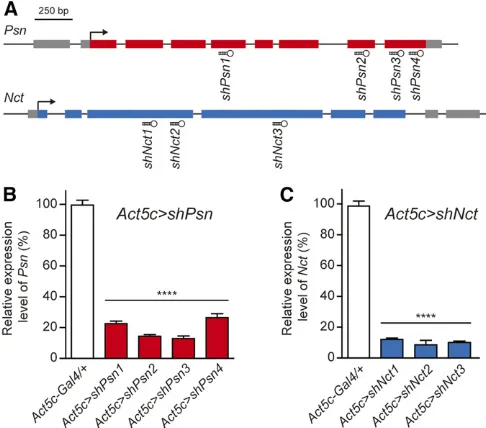
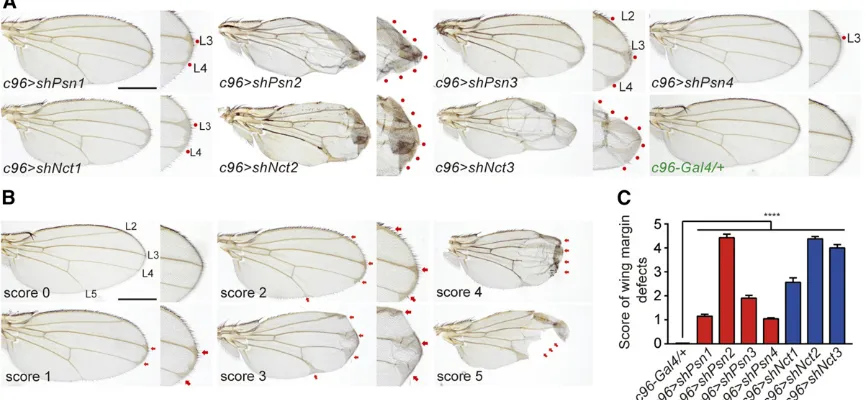
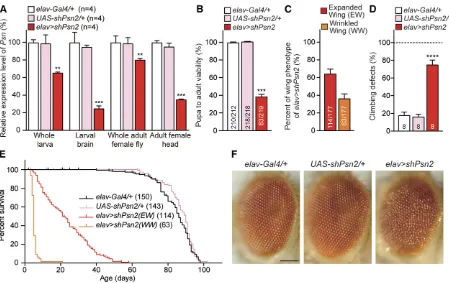
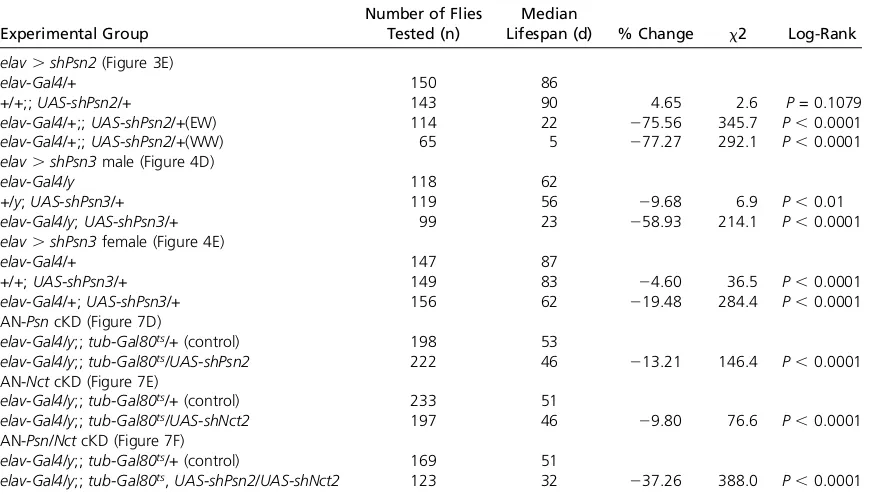
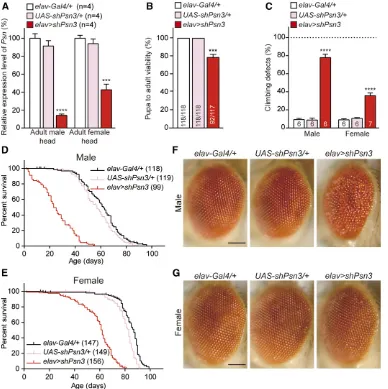
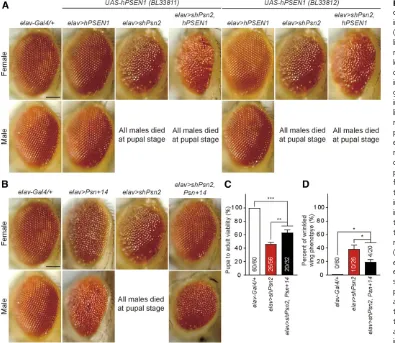
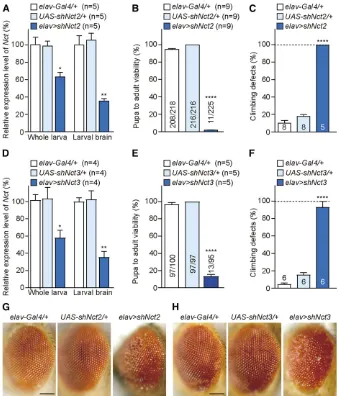
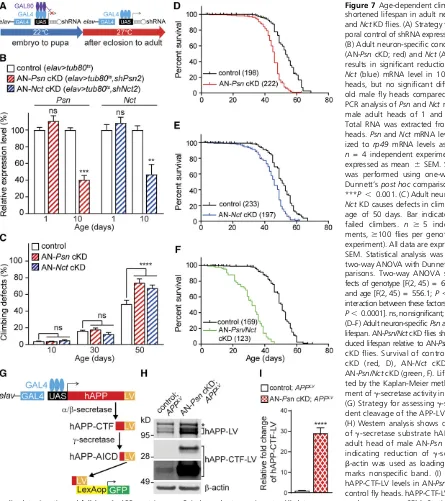
![Figure 8ies died before the age post hoctors [F(12, 197) = 19.94; P , 0.0001]; ns, nonsig-niP , 0.05, **P , 0.01,****in frontal brain sections revealed age-dependent neu-in the brain](https://thumb-us.123doks.com/thumbv2/123dok_us/1519645.1186235/11.603.50.361.39.527/figure-hoctors-nonsig-frontal-brain-sections-revealed-dependent.webp)
